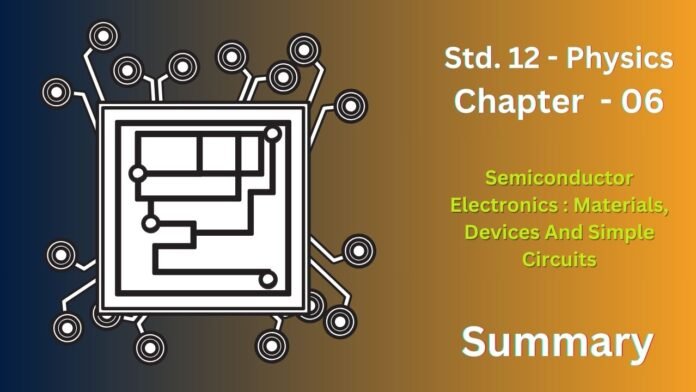The chapter “Semiconductor Electronics: Materials, Devices and Simple Circuits” from the 12th standard Physics part 2 NCERT textbook explores the world of semiconductor devices and their applications in electronic circuits. It bridges the gap between fundamental physics and practical technology, explaining how semiconductors enable modern electronics.
Here’s a summary of the key concepts:
- Energy Bands in Solids: The chapter begins by discussing the energy bands in solids, differentiating between conductors, insulators, and semiconductors. It explains how the presence of a forbidden energy gap determines the electrical conductivity of a material. Conductors have overlapping bands, insulators have a large energy gap, and semiconductors have a moderate energy gap.
- Semiconductors: Semiconductors, like silicon and germanium, have electrical conductivity between that of conductors and insulators. Their conductivity can be controlled by adding impurities (doping).
- Intrinsic and Extrinsic Semiconductors:
- Intrinsic semiconductors are pure semiconductors with low conductivity. Their conductivity increases with temperature.
- Extrinsic semiconductors are doped semiconductors. Doping involves adding small amounts of impurity atoms to increase conductivity.
- Doping: Doping creates either n-type or p-type semiconductors.
- n-type semiconductors: Doped with pentavalent impurities (like phosphorus), which provide extra electrons. Electrons are the majority carriers.
- p-type semiconductors: Doped with trivalent impurities (like boron), which create “holes” (vacancies where electrons are missing). Holes are the majority carriers.
- p-n Junction: A p-n junction is formed when a p-type and an n-type semiconductor are joined together. An electric field exists across the depletion region.
- Semiconductor Diode: A p-n junction acts as a diode, allowing current to flow easily in one direction (forward bias) and blocking current in the opposite direction (reverse bias). The chapter discusses the current-voltage characteristics of a diode.
- Rectifiers: Diodes are used to convert AC current to DC current. The chapter explains half-wave and full-wave rectifiers.
- Special Purpose Diodes: The chapter briefly introduces some special purpose diodes, such as:
- Zener diode: Operates in the reverse breakdown region and is used as a voltage regulator.
- Light-emitting diode (LED): Emits light when current passes through it in the forward direction.
- Photodiode: Conducts current when light falls on it.
- Solar cell: Converts light energy into electrical energy.
- Transistors: Transistors are three-terminal semiconductor devices that can amplify signals or act as switches. The chapter discusses the operation of bipolar junction transistors (BJTs) and their use in amplifier and oscillator circuits. It covers the common emitter configuration in detail.
- Digital Electronics and Logic Gates: The chapter introduces the basics of digital electronics, where signals have only two values (0 and 1). It explains the operation of logic gates (AND, OR, NOT, NAND, NOR) and how they can be combined to perform logical operations.
- Integrated Circuits (ICs): The chapter concludes with a brief discussion of integrated circuits (ICs), which are tiny chips containing many transistors and other components, enabling complex electronic circuits to be miniaturized.
Exercise
1. In an n-type silicon, which of the following statement is true:
(a) Electrons are majority carriers and trivalent atoms are the dopants.
(b) Electrons are minority carriers and pentavalent atoms are the dopants.
(c) Holes are minority carriers and pentavalent atoms are the dopants.
(d) Holes are majority carriers and trivalent atoms are the dopants.
Ans :
The correct answer is (c)
2. Which of the statements given in Exercise 14.1 is true for p-type semiconductos.
Ans :
Holes are majority carriers and trivalent atoms are the dopants.
3. Carbon, silicon and germanium have four valence electrons each. These are characterised by valence and conduction bands separated by energy band gap respectively equal to (E). (E) and (E)- Which of the following statements is true?
Ans :
The correct answer is (c) (E_g)_C > (E_g)_Si > (E_g)_Ge
4. In an unbiased p-n junction, holes diffuse from the p-region to n-region because
(a) free electrons in the n-region attract them.
(b) they move across the junction by the potential difference.
(c) hole concentration in p-region is more as compared to n-region.
(d) All the above.
Ans :
The correct answer is (c) hole concentration in the p-region is more as compared to the n-region.
5. When a forward bias is applied to a p-n junction, it
(a) raises the potential barrier.
(b) reduces the majority carrier current to zero.
(c) lowers the potential barrier.
(d) None of the above.
Ans :
The correct answer is (c) lowers the potential barrier.
6. In half-wave rectification, what is the output frequency if the input frequency is 50 Hz. What is the output frequency of a full-wave rectifier for the same input frequency.
Ans :


